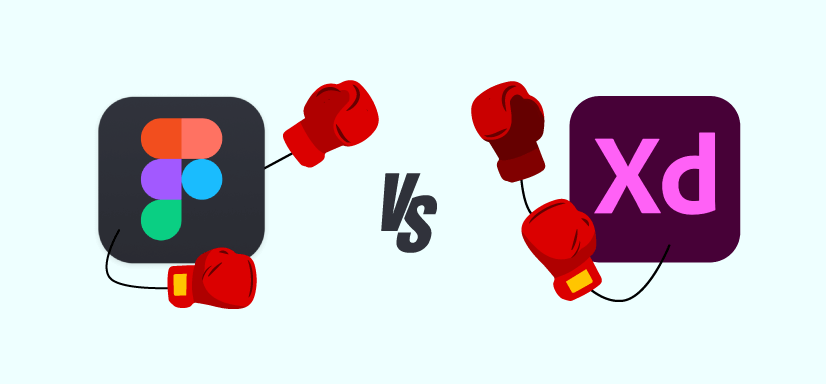Figma vs. Adobe XD: Which One I Use & Why?

Figma vs. Adobe XD: Which One I Use & Why
When deciding between design tools, it’s not about which one is “better” in every situation — it’s about which one best fits my workflow, team needs, and project constraints. After using both Figma and Adobe XD, here’s how I compare them, and why I tend to favor one over the other.
What Are They
-
Figma is a cloud‑based UI/UX design and prototyping tool that works in the browser (and via desktop apps) that emphasizes real‑time collaboration, design systems, and cross‑platform access.
-
Adobe XD is Adobe’s vector‑based design/prototyping app integrated into the Creative Cloud ecosystem. It offers tools for wireframes, mockups, interactive prototypes, etc.
Key Differences: Strengths & Weaknesses
Here are some of the differences I’ve found especially relevant, based on recent documentation, reviews and using both in real projects:
| Feature Area | Figma Strengths | Adobe XD Strengths | Things to Watch / Weaknesses |
|---|---|---|---|
| Collaboration & Sharing | Real‑time editing by multiple users, browser‑based, easy to leave comments, great for remote/team projects. GeeksforGeeks+2DarwinApps Blog+2 | Co‑editing features; share previews; but collaboration tends to be less seamless than Figma. DarwinApps Blog+1 | Figma depends heavily on a good internet connection; large, complex files can lag. XD is more stable offline but less flexible in real‑time team editing. GeeksforGeeks+1 |
| Design Systems / Reuse of Components | Excellent support for shared libraries, variants/components, style guides. Makes consistency and scaling easier. Digital Regenesys+2Kreafolk+2 | Works well especially if you already use other Adobe tools — its integration can make asset reuse easier across Photoshop, Illustrator etc. GeeksforGeeks+1 | XD’s component/variant system has fewer “bells and whistles” than Figma, especially when scaling to large teams or many variants. Reddit+1 |
| Prototyping & Interactivity | Solid prototyping, clean workflows, easy sharing. Figma has made big improvements. numi.tech+1 | XD offers some advanced prototyping features: voice, gestures, auto‑animation transitions etc. If you need more complex interactivity, XD can have the edge. GeeksforGeeks+2computan.com+2 | Figma may require plugins or workarounds for some specific advanced interactions; XD may lag in collaboration or web/browser‑based version. Dev Genius+1 |
| Platforms & Accessibility | Since it runs in the browser (and via desktop), Figma works across Mac, Windows, Linux. Very useful when working with people who don’t use the same OS. GeeksforGeeks+1 | XD is desktop‑based; works well on Mac and Windows; more limited in terms of browser/web access. Pttrns+1 | If you often need offline work, XD is better; if you’re always connected, Figma is strong. But unreliable internet can make browser tools frustrating. GeeksforGeeks+1 |
| Pricing & Value | Figma offers a generous free tier, and the paid versions scale well for teams. Kreafolk+1 | XD is part of Adobe’s Creative Cloud; you might benefit from licenses you already have. Some advanced features are behind paywalls. computan.com+1 | If budget is tight (especially for individuals/freelancers or small teams), Figma tends to give more usable features without needing to pay. Digital Regenesys+1 |
Which One I Use & Why
After trying both in projects — solo, collaborative, large scale, small scale — I tend to use Figma. Here’s why:
-
Collaboration & Speed
Real‑time collaboration is amazing. I can work with teammates (designers, developers, stakeholders) simultaneously, leave comments, see feedback, iterate fast. It reduces back‑and‑forth. -
Design Systems & Scalability
When a project grows, I need a consistent design system, scalable components, variants, styles. Figma handles this more cleanly (for me) with less friction. -
Cross‑Platform & Accessibility
Since I sometimes work across Windows, Mac, even remotely with others on different OS, the browser‑based access is very helpful. It reduces “well, I can’t open this file” problems. -
Cost & Value
Especially when freelancing or working in smaller teams, Figma’s free / lower‑cost plans give enough power. Paying small increments for more features feels more manageable. -
Active Community & Plugins
The ecosystem around Figma — plugins, community templates, components — is very strong. This helps speed up mockups, wireframes, assets reuse.
Situations Where Adobe XD Might Be Better
While I lean toward Figma, there are times when Adobe XD might be the right choice:
-
If the project requires very advanced prototyping (voice, gestures, or very custom transitions) that XD handles natively better.
-
If your team is deeply embedded in the Adobe Creative Cloud ecosystem (lots of work in Photoshop, Illustrator, After Effects, etc.) — asset flow might be smoother in XD.
-
If you are going somewhere with limited internet connection, where offline working is essential.
-
For some small, quick projects or presentations, where the overhead of setting up Figma may feel more than just using XD (if already available).
My Recommendation (for You)
If you’re wondering “Which should you use?”, here’s a quick checklist—pick whichever aligns more with your priorities:
| Priority | Go with Figma if… | Go with Adobe XD if… |
|---|---|---|
| Need real‑time team collaboration, comment/feedback loop | Yes | Maybe less ideal |
| Frequently changing / scaling design systems | Yes | Only if small scale or limited components |
| Working across different OS or remote team members | Yes | Less flexible |
| Need advanced prototyping with voice / gesture / special animations | Possibly XD | Only if those features are critical |
| Budget is tight or you want more for free | Figma | XD only if you already have Adobe license/investment |
| Need offline work or you frequently work without stable internet | XD | Figma may struggle |